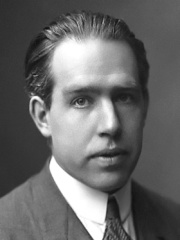
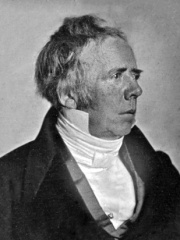

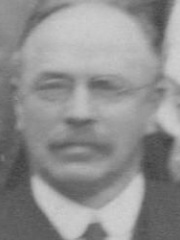
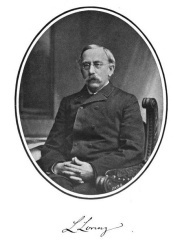
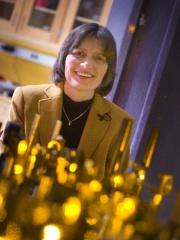
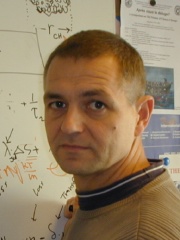
The Most Famous
PHYSICISTS from Denmark
This page contains a list of the greatest Danish Physicists. The pantheon dataset contains 851 Physicists, 8 of which were born in Denmark. This makes Denmark the birth place of the 17th most number of Physicists behind Hungary, and Canada.
Top 8
The following people are considered by Pantheon to be the most legendary Danish Physicists of all time. This list of famous Danish Physicists is sorted by HPI (Historical Popularity Index), a metric that aggregates information on a biography's online popularity.

1. Niels Bohr (1885 - 1962)
With an HPI of 85.49, Niels Bohr is the most famous Danish Physicist. His biography has been translated into 141 different languages on wikipedia.
Niels Henrik David Bohr (; Danish: [ˈne̝ls ˈpoɐ̯ˀ]; 7 October 1885 – 18 November 1962) was a Danish theoretical physicist who made foundational contributions to understanding atomic structure and quantum theory, for which he received the Nobel Prize in Physics in 1922. He was also a philosopher and a promoter of scientific research. Bohr developed the Bohr model of the atom, in which he proposed that energy levels of electrons are discrete and that the electrons revolve in stable orbits around the atomic nucleus but can jump from one energy level (or orbit) to another. Although the Bohr model has been supplanted by other models, its underlying principles remain valid. He conceived the principle of complementarity: that items could be separately analysed in terms of contradictory properties, like behaving as a wave or a stream of particles. The notion of complementarity dominated Bohr's thinking in both science and philosophy. Bohr founded the Institute of Theoretical Physics at the University of Copenhagen, now known as the Niels Bohr Institute, which opened in 1920. Bohr mentored and collaborated with physicists including Hans Kramers, Oskar Klein, George de Hevesy, and Werner Heisenberg. He predicted the properties of a new zirconium-like element, which was named hafnium, after the Latin name for Copenhagen, where it was discovered. Later, the synthetic element bohrium was named after him because of his groundbreaking work on the structure of atoms. During the 1930s, Bohr helped refugees from Nazism. After Denmark was occupied by the Germans, he met with Heisenberg, who had become the head of the German nuclear weapon project. In September 1943 word reached Bohr that he was about to be arrested by the Germans, so he fled to Sweden. From there, he was flown to Britain, where he joined the British Tube Alloys nuclear weapons project, and was part of the British mission to the Manhattan Project. After the war, Bohr called for international cooperation on nuclear energy. He was involved with the establishment of CERN and the Research Establishment Risø of the Danish Atomic Energy Commission and became the first chairman of the Nordic Institute for Theoretical Physics in 1957.

2. Hans Christian Ørsted (1777 - 1851)
With an HPI of 85.42, Hans Christian Ørsted is the 2nd most famous Danish Physicist. His biography has been translated into 90 different languages.
Hans Christian Ørsted (Danish: [ˈɶɐ̯steð] ; 14 August 1777 – 9 March 1851), sometimes transliterated as Oersted ( UR-sted), was a Danish chemist and physicist who discovered that electric currents create magnetic fields. This phenomenon is known as Oersted's law. He also discovered aluminium, a chemical element. A leader of the Danish Golden Age, Ørsted was a close friend of Hans Christian Andersen and the brother of politician and jurist Anders Sandøe Ørsted, who served as Prime Minister of Denmark from 1853 to 1854.

3. Aage Bohr (1922 - 2009)
With an HPI of 75.84, Aage Bohr is the 3rd most famous Danish Physicist. His biography has been translated into 77 different languages.
Aage Niels Bohr (Danish: [ˈɔːwə ˈne̝ls ˈpoɐ̯ˀ] ; 19 June 1922 – 8 September 2009) was a Danish nuclear physicist who shared the Nobel Prize in Physics in 1975 with Ben Roy Mottelson and James Rainwater "for the discovery of the connection between collective motion and particle motion in atomic nuclei and the development of the theory of the structure of the atomic nucleus based on this connection". His father was Niels Bohr. Starting from Rainwater's concept of an irregular-shaped liquid drop model of the nucleus, Bohr and Mottelson developed a detailed theory that was in close agreement with experiments. Since his father, Niels Bohr, had won the prize in 1922, he and his father are one of the several pairs of fathers and sons who have both won the Nobel Prize.

4. Martin Knudsen (1871 - 1949)
With an HPI of 60.75, Martin Knudsen is the 4th most famous Danish Physicist. His biography has been translated into 24 different languages.
Martin Hans Christian Knudsen (15 February 1871 in Hasmark on Funen – 27 May 1949 in Copenhagen) was a Danish physicist who taught and conducted research at the Technical University of Denmark. He is primarily known for his study of molecular gas flow and the development of the Knudsen cell, which is a primary component of molecular beam epitaxy systems. Knudsen received the university's gold medal in 1895 and earned his master's degree in physics the following year. He became lecturer in physics at the university in 1901 and professor in 1912, when Christian Christiansen (1843–1917) retired. He held this post until his own retirement in 1941. Knudsen was renowned for his work on kinetic-molecular theory and low-pressure phenomena in gases. His name is associated with the Knudsen flow, Knudsen diffusion, Knudsen number, Knudsen layer and Knudsen gases. Also there is the Knudsen equation; two instruments, the Knudsen absolute manometer and Knudsen gauge; and one gas pump that operates without moving parts, the Knudsen pump. His book, The Kinetic Theory of Gases (London, 1934), contains the main results of his research. Knudsen was also very active in physical oceanography, developing methods of defining properties of seawater. He participated as hydrographer on the Ingolf expedition in the North Atlantic in 1895-96. By means of his for the purpose constructed precision thermometer, capable of measuring water temperature in the deep sea with a precision of 1/100°C, it was demonstrated that the water masses at the sea floor north of the Wyville Thompson Ridge were consistently a few degrees colder than south of the ridge and likely explained the differences in the deep sea fauna on either sides of the ridge. He was editor of Hydrological Tables (Copenhagen–London, 1901). In 1927, he was one of the participants of the fifth Solvay Conference on Physics that took place at the International Solvay Institute for Physics in Belgium. He was awarded the Alexander Agassiz Medal of the U.S. National Academy of Sciences in 1936. He was made a Commander First Class of the Order of the Dannebrog.
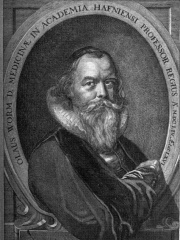
5. Ole Worm (1588 - 1654)
With an HPI of 59.64, Ole Worm is the 5th most famous Danish Physicist. His biography has been translated into 25 different languages.
Ole Worm (13 May 1588 – 31 August 1654), who often went by the Latinized form of his name Olaus Wormius, was a Danish physician, natural historian and antiquary. He was a professor at the University of Copenhagen where he taught Greek, Latin, physics and medicine.

6. Ludvig Lorenz (1829 - 1891)
With an HPI of 59.20, Ludvig Lorenz is the 6th most famous Danish Physicist. His biography has been translated into 24 different languages.
Ludvig Valentin Lorenz ( LORR-ənts; 18 January 1829 – 9 June 1891) was a Danish physicist and mathematician. In 1867, he gave completely general integral solutions to the differential equations of electromagnetism, which contain retardation effects reflecting the finite speed of light. This paper also introduces the Lorenz gauge, named after him. Lorenz also developed mathematical formulae to describe phenomena such as the relation between the refraction of light and the density of a pure transparent substance, and the relation between a metal's electrical and thermal conductivity and temperature (Wiedemann–Franz–Lorenz law). His name is sometimes confused with that of the physicist Hendrik Antoon Lorentz, who is incorrectly credited for Lorenz's work.

7. Lene Hau (b. 1959)
With an HPI of 52.96, Lene Hau is the 7th most famous Danish Physicist. Her biography has been translated into 29 different languages.
Lene Vestergaard Hau (Danish: [ˈle̝ːnə ˈvestɐˌkɒˀ ˈhɑw]; born November 13, 1959) is a Danish physicist and educator. She is the Mallinckrodt Professor of Physics and of Applied Physics at Harvard University. In 1999, she led a Harvard University team who, by use of a Bose–Einstein condensate, succeeded in slowing a beam of light to about 17 metres per second, and, in 2001, was able to stop a beam completely. Later work based on these experiments led to the transfer of light to matter, then from matter back into light, a process with important implications for quantum encryption and quantum computing. More recent work has involved research into novel interactions between ultracold atoms and nanoscopic-scale systems. In addition to teaching physics and applied physics, she has taught Energy Science at Harvard, involving photovoltaic cells, nuclear power, batteries, and photosynthesis. In addition to her own experiments and research, she is often invited to speak at international conferences, and is involved in structuring the science policies of various institutions. She was keynote speaker at EliteForsk-konferencen 2013 ("Elite Research Conference") in Copenhagen, which was attended by government ministers, as well as senior science policy and research developers in Denmark. In acknowledgment of her many achievements, Discover Magazine recognized her in 2002 as one of the 50 most important women in science.

8. Henrik Svensmark (b. 1958)
With an HPI of 52.07, Henrik Svensmark is the 8th most famous Danish Physicist. His biography has been translated into 16 different languages.
Henrik Svensmark (born 1958) is a Danish physicist and professor in the Division of Solar System Physics at the Danish National Space Institute (DTU Space) in Copenhagen. He is known for his work on the hypothesis that fewer cosmic rays are an indirect cause of global warming via cloud formation.
People
Pantheon has 8 people classified as Danish physicists born between 1588 and 1959. Of these 8, 2 (25.00%) of them are still alive today. The most famous living Danish physicists include Lene Hau, and Henrik Svensmark. The most famous deceased Danish physicists include Niels Bohr, Hans Christian Ørsted, and Aage Bohr.
Living Danish Physicists
Go to all RankingsDeceased Danish Physicists
Go to all RankingsNiels Bohr
1885 - 1962
HPI: 85.49
Hans Christian Ørsted
1777 - 1851
HPI: 85.42
Aage Bohr
1922 - 2009
HPI: 75.84
Martin Knudsen
1871 - 1949
HPI: 60.75
Ole Worm
1588 - 1654
HPI: 59.64
Ludvig Lorenz
1829 - 1891
HPI: 59.20
Overlapping Lives
Which Physicists were alive at the same time? This visualization shows the lifespans of the 5 most globally memorable Physicists since 1700.

